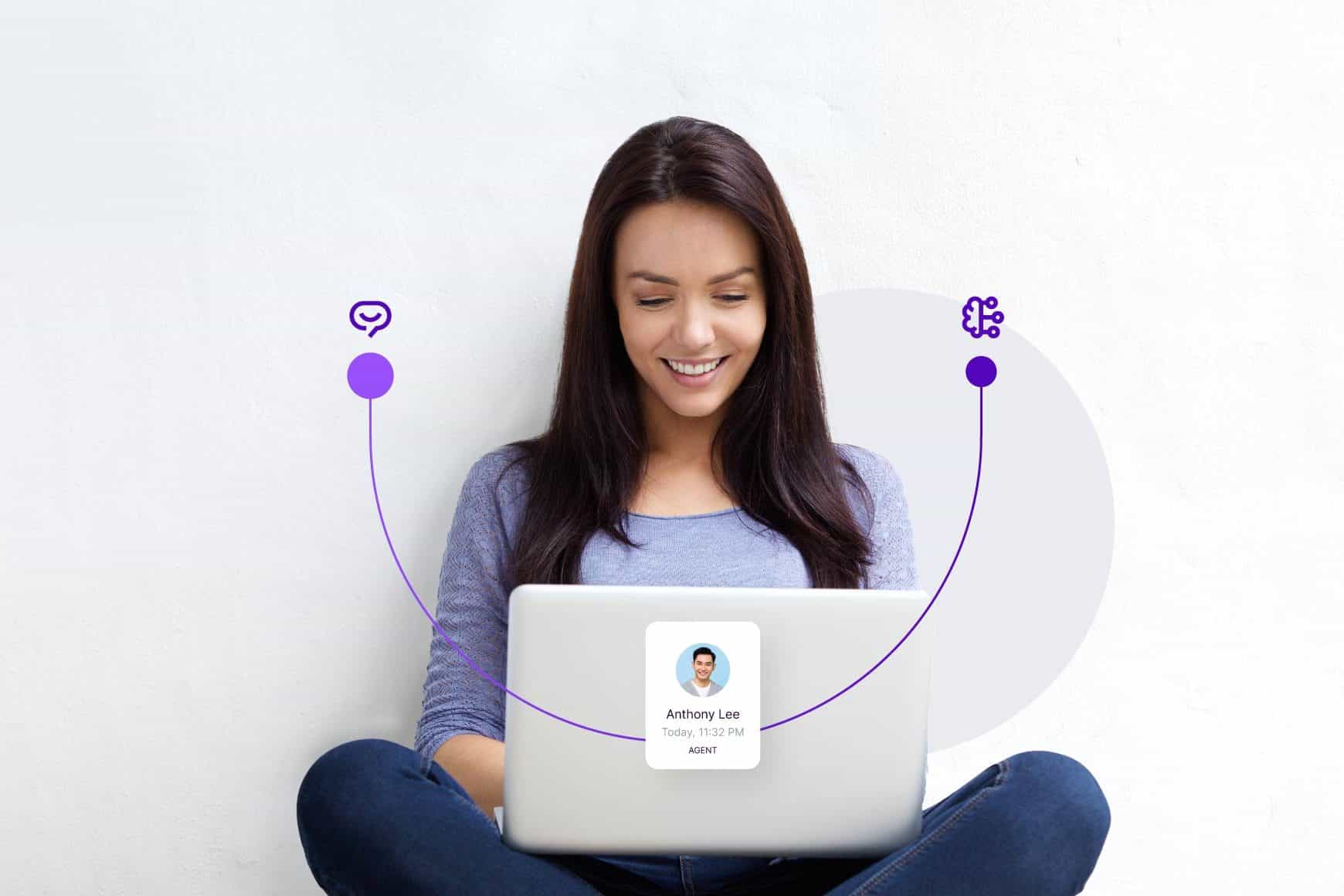What are voicebots and how do they elevate customer experience?

By Marta Lima
0 min read

“Alexa, turn on the radio” is the first sentence a lot of people kick-start their mornings with.
Looking closely at our daily lives, a lot of us rely on artificial intelligence (AI) powered voicebots technology to make tasks easier and faster—whether it is asking Google for directions or Siri to return that missed phone call from our boss.
AI voice technology has entered our lives and it’s here to stay—redefining the way we communicate, work, and shop. Voicebots, being among the most popular automation solutions, are quickly becoming a must-have for customer service.
If you are wondering how this technology actually works and how it is shaping the customer experience (CX), you are in the right place to find out. Get your questions answered:
What is a voicebot and how does it work?
A voicebot, also called a virtual agent, is software powered by AI, natural language processing (NLP), and machine learning that allows users to interact with a device or service through their voice. In other words, a voicebot is capable of understanding, interpreting, analyzing requests, and responding to them vocally with everyday words, which is called natural language. Voicebots offer intelligent, natural, and intuitive interactions, opening up a whole new world for customer self-service.
From a technical point of view, a voicebot is based on conversational AI. First, as the user is speaking, the system detects voice through voice activity detection (VAD). The sound is then transformed into text thanks to an automatic speech recognition (ASR) system. These two components make the speech-to-text (STT) engine capable of transcribing the voice into written text.
Then, NLP is able to analyze the text and understand the objective and context of the user’s request from the used words in a very human-like form. Finally, the voicebot chooses the most appropriate answer and verbalizes it through a text-to-speech (TTS) engine.

Given the rise of AI and advanced speech recognition technologies, interactive voicebots are becoming one of the most used customer self-service tools. Voicebots offer natural and user-friendly communication and allow customers to interact with them while performing their daily routine, which is why they have a huge potential for elevating the level of customer service a contact center offers.

Chatbot vs. voicebot vs. IVR: What’s the difference?
Chatbots, voicebots, and interactive voice response (IVR) talk to us every day. They have a common goal—find the best answer or concretize a request of the customer— so what makes them different?
Chatbot vs. voicebot. Although they have the same technology, a voicebot, and a chatbot don’t operate on the same channel. As the name suggests, a voicebot only works on the voice channel. On the other hand, the chatbot uses the text channel and only works on a website or an application.
Since a voicebot only works on a voice channel, it requires two additional features compared to the chatbot:
- Voice recognition to transform a sound into a sequence of words that will be analyzed by the same type of engine as a chatbot.
- Speech synthesis, which allows the virtual assistant to transmit the answer verbally.
A lot of companies use chatbots to deliver better customer service, as they simulate real-life communication through chat in a fast and effective way. Users can write a message through a chat addressing a request or complaint or even purchasing a product or service.
At the end of the day, chatbots and voicebots serve the same purpose: to engage with customers in simple, interactive, and personalized conversations. The biggest difference between them is the natural accessibility of voicebots: people can make requests completely hands-free, without the need to manually input text.
Voicebot vs. IVR. IVR is one of the most widely used systems to manage inbound queries in a contact center. It supports live agents in sorting calls by topic, identifying the reason customers are calling, and transferring that call to the most adequate agent. But although they give great customer support, traditional touch‑tone IVR systems are usually based on long and complex menus to get to the right option—which may not even appear—and do not meet the needs of modern consumers.
A voicebot is a conversational IVR that, instead of expecting the customer to listen to and choose from a set of options, applies machine learning technology to understand and capture customers’ intent from their speech quickly and efficiently and route them to the right agent. Voicebots simply ask, “How can I help you?” and allow customers to interact with the system naturally, using their own words. Machine learning technology enables voicebots to constantly improve.
What are the benefits of using a voicebot in contact centers?
CX expectations are very high and growing by the day. Gone are the days in which customers would exclusively reach out to customer support telephone lines. Modern customers expect organizations to be available anytime on various channels, and to offer a careful and personalized assistant throughout the whole customer journey, which makes contact centers a highly relevant part of every business.
But where do voicebots fit into this scenario? Voicebots can highly benefit customer support in contact centers, working as a self-service tool that performs simple operations without the need for human intervention— simplifying the workload of human agents, reducing the operational costs, and offering a fast, efficient, and autonomous resolution for customer issues.
Voicebots in contact centers allow businesses to:
- Reduce customer service contact rate and operational costs.
One of the most significant benefits that voicebots bring to contact centers is helping to optimize resources and reduce customer service contact rates by automating simple customer interactions that do not require human intervention. Moreover, they free human agents from repetitive tasks, giving them more time to concentrate on more important tasks.
- Scale business operations easily and quickly.
Voicebots don’t have any limit for conversations or operations which means businesses can easily scale customer service up or down based on specific needs, such as seasonal peaks.
- Integrate with other applications.
Voicebots seamlessly integrate with customer support technology like customer relationship management (CRM), global distribution system (GDS), or a knowledge base.
- Automate identification and verification processes.
Almost every contact center interaction starts with agents asking the callers to identify themselves by providing specific information—phone number, date of birth, number ID, etc. This initial process takes up a lot of agents’ time, adding to the interaction cost and forcing agents to rush through the actual resolution. Voicebots automate the identification and verification process by collecting relevant information and making it available to the agent to use during the conversation with the customer.
- Support employees.
Voicebots can support contact center employees throughout the customer journey—during a call, by proactively delivering information about the customer in a single interface, and after, by analyzing the call and recommending next best actions according to the requests of the customer or even their tone of voice. Voicebots can improve the quality of the agents’ work and support them to be at their best performance.
How can a voicebot improve CX?
Improving CX is a top priority in any business. A delightful CX creates loyal customers, who are more likely to buy again and recommend a service or product to family and friends. Voicebots meet the expectation of today’s customers when it comes to speed, ease of accessibility, and autonomy making them a perfect tool for customer support.
Here are five ways you can elevate your CX using voicebots:
- Create personalized customer relationships.
Voicebots bring new opportunities for personalization in customer support. For instance, using voice recognition, voicebots can quickly validate customer data and use information, like the customer’s history with the brand, to deliver tailored responses.
Due to the fact that voicebots are powered by AI and machine learning, even if they fail to respond to a customer’s needs, they learn from the interaction and begin to contextualize future responses based on that learning. Furthermore, human-in-the-loop technology leverages agents’ judgment and expertise to train voicebots and other AI models. In other words, they are constantly learning to deliver better experiences.
- Provide fast, accessible, and autonomous customer service.
Unlike human agents, voicebots are available 24/7, which means customers can get information and have their questions answered at any time. Customers can use voicebots to get answers to either common questions, such as “where is my order?”, to more urgent requests, such as canceling a lost credit card.
- Improve response times.
Voicebots keep customers from having to wait too long to speak with an agent. Even if the voicebot is not able to resolve an issue, answering the customer’s call immediately, rather than making them wait, can prevent a customer from getting frustrated or hanging up the call.
- Offer a consistent and inclusive customer experience.
Voicebots ensure that customers have more inclusive interactions. A live agent is hardly fluent in multiple languages to address customer inquiries worldwide. Voicebots overcome this barrier and make sure that all customers receive the same level of service, regardless of the language they speak.
- Proactively engage customers.
Voicebots can proactively reach out to customers with notifications of appointment reminders, due dates, offers/discounts, renewals, and customer feedback surveys saving both time and money.
Contact center voicebots use cases by industry.
Regardless of the industry, every company can take advantage of voicebots as a customer service tool. Here are some examples of industry-specific use cases for voicebot technology:
In banking: Deliver proactive recommendations and financial insights. Banks collect a wide range of data on customers’ spending and saving habits, but they often struggle to use this data in a valuable manner. Voice assistants can provide customers with personal finance insights, such as an overview of recurring transactions, pending payment reminders, and proactive recommendations such as saving opportunities and investment advice.
In retail: Real-time order-related information. “Where is my order” is one of the most common retail customer-service questions. Voicebots can solve high volumes of such queries providing real-time order-related information. Shoppers just need to give the order number. The voicebot will then provide them with information on the order location, estimated arriving date, and further options like cancel, return, or modify the order.
In healthcare: Finding a doctor. In the healthcare industry, payers can implement voicebots to help their members find a doctor within their residential area and according to their health needs. The voicebot asks members questions about their zip code and medical specialty and then gives them recommendations meeting their criteria.
In government: Improve the citizen experience. Known for its complex customer service, the public sector can benefit a lot from this technology. Voicebots can help governments to help citizens navigate through the bureaucracy and provide 24/7 information on filing taxes, registering vehicles, updating passports, among others.
Voicebots are on their way to becoming indispensable in our lives. Their functionality keeps offering us fluidity, speed, and time savings across a wide diversity of needs. On the business side, they also bring a high potential of growth and competitive advantage, especially in terms of customer service. Customer expectations and demand for voice-enabled applications will continue to increase, and businesses must focus on offering voice capabilities to deliver delightful and agile conversation experiences that are able to resolve customer issues in a blink of an eye.








